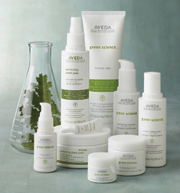The marketing trends programme of presentations was big on promises and delivery at this year’s in-cosmetics in Milan, as Imogen Matthews reports
A record number of attendees were at in-cosmetics’ trends presentations to get the latest market data and learn more about the current thinking on key industry issues including sustainability and anti-ageing.
Kline’s opening presentation, from industry manager Anna Ibbotson, confirmed that the global personal care market, worth $300bn in 2010 at retail, has held up well within the economy as a whole. The biggest change has been in skin care, which has grown to become the largest sector (30%) compared to its number five position five years ago.
“Anti-ageing is driving growth in skin care,” confirmed Ibbotson, “with one in two UK consumers concerned with how they are perceived in and outside the workplace. It provides a great opportunity for ingredient manufacturers.” Other growth opportunities include naturals, home devices, beauty from within and male grooming.
Irina Barbalova, head of global beauty and personal care research, Euromonitor International, warned that consumer expenditure in western Europe has been the slowest to recover. “The industry has emerged from recession, but recovery is slow and uneven,” she affirmed. “However, the recovery is faster than originally expected.” She maintained that consumer needs are more diverse post-recession as they become value seeking, demanding of services and experiences and being digitally connected.
In terms of product categories, Euromonitor records skin care and colour cosmetics as being weak, whilst staple categories such as oral care and shower products have picked up. Hair care struggled in 2010 but premium shampoos doubled growth in Russia, helping to pull up hair care sales overall. Baby care and men’s products also achieved strong results. Barbalova highlighted private label as an area of growth due to an increased pace of innovation. “Their portfolio of sophisticated formulations resonates with consumers,” she said, observing that private label taps into both budget and high end lines with a focus on product efficacy and ingredients, many of which are ‘green’, and a trend towards diversifying existing lines. According to Euromonitor, future global growth will be driven by mass beauty, especially in mass fragrance, due to the strength of the Latin American market, while opportunities still exist for premium skin care in China, Japan and the US.
Kline’s personal care ingredient trends showed that volume consumption was approximately 575,000 tonnes in 2009, based on eight categories. “Europe was the largest region for personal care ingredients post recession and China is gaining share from Europe and the US and is now ahead of Japan,” stated Ibbotson. China’s growth has in part come from emollients, which are part of the global natural trend. Moving forward, Ibbotson earmarked China and India as providing significant opportunities for personal care ingredient growth.
When it comes to innovation, Gillian Morris, director in the chemicals & materials consulting practice, Kline, demonstrated that the industry’s view differs from that of the consumer. According to a Kline Pulse survey of 500 people, consumers were found to respond well to newness in unexpected ways. “They talked about tactile aspects, packaging, performance and marketing communication,” affirmed Morris. “However, they have a fine memory recall of the products they use and are confused when it starts to change. Consumers don’t want changes made to current products which perform well already and are frustrated with products being deleted.” Her advice to manufacturers was: “If it works, keep it on the market.”
High-tech skin care
Anti-ageing remains a key area of new product development and has been growing in importance. According to Mintel, anti-ageing is the fourth most prevalent claim in skin care. Europe was the largest anti-ageing skin care market in 2010, with sales of €2.4bn amongst the Big 5, while the US registered mass market sales of $804m. “People want to look good for their age as long as possible,” affirmed Vivienne Rudd, senior European beauty analyst, who highlighted the key claims made for recent anti-ageing skin care launches. They include sirtuins, fullerenes, SOD, human oliopeptide-1 (EGF), NGF (nerve growth factor), animal derived placenta/collagen, stem cells, neuro skin theory and anti-ageing devices used in skin care and for home laser technology. Rudd highlighted finished product examples for each of these categories. Trends include:
• Topical collagen: products which supply collagen to the skin as well as promote from within
• EGF: the growth trajectory is steep with a doubling of launches between 2008-10
• Fullerenes: were launched several years ago but due to consumer concerns with nanotechnology fell from favour. They are now back with a doubling of launches and Mintel anticipates more
• Stem cells: Europe takes the lead in formulations, most of which arem so far based around apple stem cell technology
• Luxury men’s anti-ageing with minerals and GAGs
Shopping habits
Contrary to the widely held belief that supermarkets have been cleaning up in cosmetics and toiletries, the long-term trends suggest more gradual growth for the grocery sector. According to Jon Wright, head of global retailing research at Euromonitor, grocery retailers have only gained 1% in global share terms over 15 years. The changes that have occurred have come from other retail channels, including beauty specialists, such as Sephora, parapharmacies and drugstores, including Superdrug, and internet retailing.
“Consumers care about quality and will pay more to go out of their way to attain assurance over quality,” stated Wright. He gave various examples of retailers who have been going that extra mile to reach out to consumers. For example, while department stores’ share of beauty has declined over the past ten years, super premium ones, including Harrods, Liberty and Fortnum & Mason, have performed better and will remain strong. Meanwhile, other department stores are fighting back, such as JC Penny, which has joined forces with Sephora in its stores in order to provide that assurance over brand quality that consumer desire.
Niche power
A new addition to the trends presentations were brand interviews with niche brands Bulldog and Forest Secrets. Simon Duffy, founder of Bulldog described how the brand was launched in the UK and is now available around the world. “It was the first natural skin care brand for men,” he explained. “We are proud of the ingredients which stack up well with L’Oréal, Nivea, Gillette etc. Bulldog is the first men’s brand to have Fairtrade certification.”
Barbara Olioso chose the name Forest Secrets because it can be compared to the skin. “It’s alive, breathes and changes with the seasons,” she explained. Whereas Bulldog has carved a niche in mainstream distribution, Forest Secrets is sold mainly online. “I find the best marketing is word of mouth,” said Olioso, who was proud to announce that her range would go on sale in Urban Retreat in Harrods in May.
Implications of sustainability
The growing importance of sustainability within the cosmetics and toiletries industry was explored in several presentations. “Green remains at the forefront of the industry as companies move toward being ‘green’ and shifting focus towards being sustainable and socially responsible,” said Ibbotson. She cited L’Oréal and Burt’s Bees as being at the forefront of the green movement.
In his presentation on the sustainable sourcing of ingredients, Amarjit Sahota, director, Organic Monitor, referred to Aveda as being really ahead in terms of sustainability. “Twenty years ago it made a pledge at the 1992 Earth Summit to source sustainable raw materials,” he explained. “Since then it has undertaken social investment projects in the Amazon and Africa, is the largest user of organic essential oils in the beauty industry and its products have a low environmental impact. It is the first beauty company to manufacture using 100% wind power.”
Sahota highlighted Dr Bronner’s Magic Soaps as the largest organic and fairtrade beauty firm. The company has social investments in Palestine and Sri Lanka and is also involved in corporate philanthropy and profit sharing.

Aveda has been committed to sustainability for over 20 years and was the first beauty company to manufacture using 100% wind power
Organic Monitor’s third case study was Weleda, described as a pioneer in sustainable development with a strong corporate ethos and the largest producer of natural medicines. Other success stories include Florame, which recently won an award for ethically sourced ingredients from Madagascar; Chanel, for its reforestation projects in Latin America; Boots’ use of organic and fairtrade ingredients and L’Oréal’s sustainable sourcing pledge.
Sahota also mentioned Beraca, which ethically sources ingredients from the Amazon; Givaudan, for its Innovative Naturals programme; and DuPont Tate & Lyle which has produced a novel range of sugar-based ingredients.
Two round table discussions linked to the in-focus feature on sustainability provided an opportunity for attendees to understand the implications with speakers from several high profile organisations. “Sustainability is a brand new concept for many companies, although it has been in use for around five years and is already often an overworked word,” said Jacques Sebag, director of Re-Source! by way of introduction. “Sustainability is not a vague marketing concept and a lot still needs to be defined.” Filipe Sabará, business director of Beraca, which sponsored the in-focus feature, agreed and called for a global standard for sustainability that consumers understand. “This would be a move towards being truly natural,” he maintained.
The importance of developing a framework for sustainable development was discussed by Olivier Jan, executive director of BIO Intelligence Service. “Lifecycle assessment is about the environmental performance of a product or service that should be assessed by using a ‘cradle to grave’ approach,” he said. Jerome Payet, director of consulting company Cycleco, added: “A footprint explains to consumers about what they buy and has been developed for over 20 years, supported by the EU. To quantify a footprint, you have to agree to a limited number of indicators, such as energy, water, ecotoxicity etc.”
P&G section head, colour cosmetics formulation design, Gillian Briggs, explained her company’s stringent criteria when implementing a lifecycle analysis. They will always demand a 10% improvement in indicators but without a decline in other indicators. “It’s a trade-off, so if there’s a change to the formula, it cannot impact on something else,” she explained.
L’Oréal has been involved in green chemistry for many years. Michel Philippe, green and sustainable chemistry manager, L’Oréal said: “Sustainable processes are very important when developing new ingredients. Green chemistry covers economic, environmental and social issues and L’Oréal has 32 assessment criteria when working with suppliers.”
The need for transparency along the supply chain was stressed by Sabará and Pascal Bordat, Aveda’s vp R&D/EL botanical technology, Estée Lauder. “Traceability is hard to achieve,” he contended. He talked about the Nagoya Protocol, which 40 countries signed up to in November 2010. “There are rules on how to access the biodiversity in terms of traditional knowledge. If you take a plant from somewhere, you must share the benefits with the people who own that place.”
Digital beauty
Sean Singleton is group md of Skive Group, one of the fastest growing UK digital media agencies whose beauty sector clients include L’Oréal. He described how traditional media is consumed passively and said so was the internet in the early days. “As the internet grew, it became about participation and consumption with many tools available to share and have conversations,” he explained. “Brands are used to controlling their brand message, but must accept a loss of control. However, there is a big opportunity for deeper conversations with these new tools.” He has seen that brands are spending more money on internet advertising, which is now bigger than TV. “Despite the recession, internet advertising is growing by 10% year on year.”

In Singleton’s experience, beauty brands have been slow to adapt to the web, but he believes we have reached a tipping point. “Brands shouting at consumers is a thing of the past,” he pointed out. “There are billions of consumers having conversations every day.” There are now over 200 million blogs and 95,000 beauty blogs and 35-49 year old women are the fastest growing group in the blogosphere. Many bloggers are providing integrated brand experiences online, such as videos on YouTube, Facebook pages and Twitter. As an example, Singleton cited Lauren Luke, a woman who started posting videos of herself applying make-up on YouTube, who has become a brand in herself.
One in four women access the internet via Smartphones and iPad devices. “Brands should make sure their website is optimised for mobile phone usage – most are not,” he said. Luckshie Haran, principal consultant, Datamonitor, went further by stating that mobile commerce is set to overtake desktop web sales by 2015.
The future lies in online meeting offline, according to Singleton, with “augmented reality” becoming a big trend in the next decade. “Stores will enhance the shopping experience using digital innovation”.
Irina Barbalova confirmed that the internet will reshape the world. According to Euromonitor data, more than 40% of the world’s population will be online in 2020. In the beauty arena, key players are increasing their online presence, though social commerce is still limited. “MAC has been the most successful, with over 1.5 million fans,” said Barbalova. “There is a clear opportunity for big and smaller niche brands who don’t have the same resources.”
Aesthetic medicine
The largest demographic group of women opting for aesthetic medicine procedures are women aged 25-70+. “Baby boomers will keep doing it once they start, even when they are 70,” maintained Emmanuelle Bassmann, md, In-Trend Ltd. However, doctors are seeing increasing numbers of younger women and the American Society for Aesthetic Plastic Surgery (ASAPS) states that 18-24 year-old women have the highest approval of cosmetic surgery, more than those over 65.
US consumers are most inclined to have cosmetic treatments, although few choose to do so. Almost three out of four Americans have not had any treatment and only 5-10% say they have. Bassmann showed that the landscape for aesthetic medicine is growing outside doctors’ offices, with medical spas and spas offering a range of treatments, including microdermabrasion, laser skin treatments and peels. “There used to be a focus on wrinkles, but nowadays it’s about improving skin texture.”
Bassmann gave details of the most popular procedures, which include Botox and fillers, pointing out that skin care maintenance programmes are on the increase. “Most dermatologists and plastic surgeons put their patients on a skin care regimen,” she affirmed. From an extensive list of physician-dispensed brands in the UK and the US, brands such as Filorga, pH Advantage, Skinceuticals, Neutrogena Clinical, GoodSkin Labs and La Roche-Posay featured. In terms of maintenance procedures, IPL features often. This is an entrance light source treatment said to reverse type one photoaging and stimulate collagen production. Peels and microdermabrasian are also top maintenance procedures.
Berengere Boucly, marketing manager, Filorga, gave a case study of how the company has used its expertise in mesotherapy to launch a range of anti-ageing dermo-cosmetics. The products mimic mesotherapy carried out in the doctor’s office (administered all over the skin using fine needles) and uses the same formula based on hyaluronic acid, vitamins, amino acids, coenzymes, minerals and antioxidants. The objective is to rejuvenate the skin using a revitalising solution.

Rooibos – popular as a tea and as a cosmetic ingredient in South Africa
South Africa C&T market trends
Southern Africa is an emerging market, for which little data currently exists. Sybille Buchwald-Werner, md of Vital Solutions, spotted the potential of this market and has conducted a consumer study to get answers on needs and expectations as well as which ingredients people look for when purchasing cosmetics and toiletries.
She discovered that the key drivers were price, natural ingredients, active ingredients and performance. “Fragrance was very important too, especially for poorer blacks who don’t shower every day. For white people, think about fragrance in the context of spa at home and aromatherapy. Fairtrade is also important to the white population.” Awareness is also high for local ingredients such as aloe vera, devil’s claw extract, rooibos extract, marula oil and baobab oil, as well as for the widely known almond oil and shea butter. The most commonly recognised actives were vitamins A, C and E.
Buchwald-Werner pointed to the growth of the middle class and increased spending power across many socio-economic groups in Southern Africa. “They look for reliable, quality skin care and hair care that meets expectations,” she said. “There are opportunities for smaller, flexible brands to enter the market with concepts that are tailored for ethnic groups and distributed in supermarkets and drugstores.” However, she warned that a market for high performance skin care ingredients and claims is not yet developed. Instead, niche products for specific ethnic groups demonstrate market potential.




